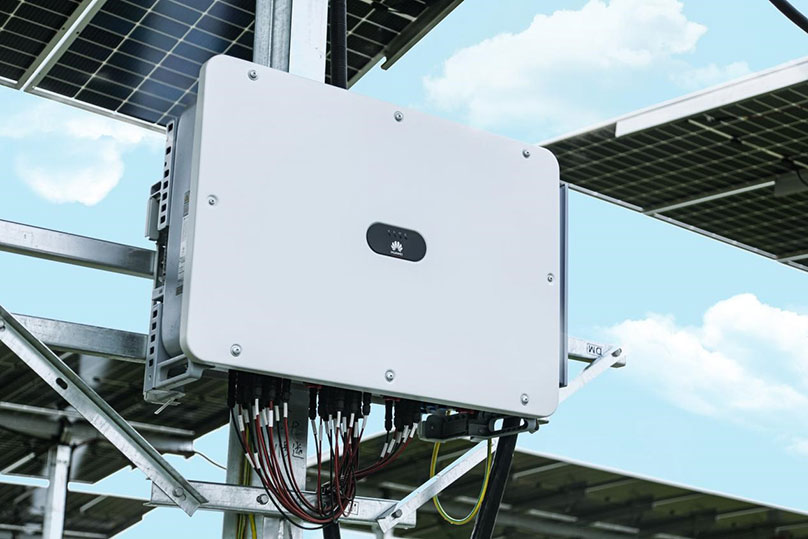Originating from Bayan Har Mountains in Qinghai Province, China, the Yalong River flows for thousands of miles,
where it eventually merges with the Jinsha River in Panzhihua, Sichuan Province. On a snowy mountain at an altitude
of 4600 meters in western Sichuan, rows of blue PV panels are generating electricity from solar energy, while the
Yalong River is roaring in the distance. This land is brought to life by clean power where solar and hydro meet.
Hydro-Solar Hybrid Enhances Energy Sources
What appears to be a "PV sea" is actually the Kela PV Plant Phase 1, the world's largest, highest-altitude, and first
GW hydro-solar hybrid power plant, with a total installed capacity of 1 GW and covering an area of 16 km2.
50 kilometers away from the Kela PV Plant, the 295 m high Lianghekou Dam stands on the Yalong River, serving for
hydropower generation and flood control. This hydropower plant has an installed capacity of 3 million kW and a total
water storage capacity of 10.8 billion m3, making critical contributions to renewable energy development in the
basin. The Kela PV Plant is connected to the Lianghekou Hydropower Plant through the 500 kV power transmission
lines, realizing hydro-solar hybrid transmission.
Digital and Intelligent Technologies Build a Benchmark Project
The Kela PV Plant is located in a cold and high-altitude area with great temperature fluctuations between day and
night. According to the staff involved in the construction, the extreme temperature in winter can reach –30.6°C, and
winds with gale force 8 or 9 often occur, making it difficult to walk. If the traditional PV plant O&M model is
used, it is difficult for employees to handle the O&M of such large scale of plant. Therefore, the Kela PV Plant has
chosen the digital and intelligent solution provided by Huawei FusionSolar and established an integrated O&M
platform, building a benchmark for high-altitude hydro-solar hybrid smart PV plants.

More than 5300 Huawei smart string inverters serve as the "heart" of the PV plant with a high protection rating of
IP66, ensuring stable and reliable operations in extreme cold environments on plateaus. FusionSolar's unique
patented Smart String-level Disconnection (SSLD) technology can intelligently identify DC side faults and implement
automatic disconnection to avoid fire risks and ensure plant safety. The Smart I-V Curve Diagnosis can perform
remote, online, and full-scanning health inspection to quickly locate faults. The smart CV diagnosis system checks
more than 2 million PV modules onsite, identifies problems such as shading, hot spots, and microcracks. The Smart
Co-Diagnosis System provides diagnosis reports for the plant, making O&M intelligent and accurate.
Huawei FusionSolar's solution uses the intelligent grid connection algorithm to enable inverters to adapt to power
grids in all scenarios (SCR ≥ 1.1) and provide excellent power quality, improving grid-connection reliability and
supporting the power output of the entire PV plant. In June this year, the Kela PV Plant was put into use, with an
estimated annual yield of 2 billion kWh, which can meet the annual electricity demand of 1 million households. The
Kela PV Plant is connected toand connected to the Lianghekou Hydropower Plant. This not only solved the problem of
renewable energy consumption, but also increased the power supply during peak hours in the summer months. The clean
power supply capacity of the Yalong River Basin exceeds 50 billion kWh.
In September 2023, the joint innovation center established by Yalong Hydro and Huawei Digital Power was officially
unveiled. As a large-scale demonstration base for hydro, wind, and solar integration, the Yalong River Basin will
become an industry innovation hub for renewable energy development. The two parties will carry out research on clean
energy base construction and O&M, plant operation safety and energy saving, and grid-forming energy storage to
provide advanced products and solutions for the industry and address various industry pain points and technical
difficulties.
"PV + Animal Husbandry" Improves Ecological and Economical Benefits
During the planning and construction of the Kela PV Plant, the local pastoral requirements were fully considered.
The PV module supports are raised to 1.8 m above the ground, leaving adequate space for grazing and vegetation
growth. PV modules can also reduce the wind speed, reduce water evaporation, and improve the soil water retention
and vegetation growth. Yaks on the plateau can freely walk and graze through the power plant.
The construction and production of the Kela PV Plant have greatly boosted local employment. More than 3000 local
jobs were created during the construction period alone. A series of enablement measures, such as "PV + green
industry," "PV + new infrastructure," and "PV + employment," will promote the collaborative development of local
agriculture, animal husbandry, tourism, and transportation sectors in the future, creating economic benefits of
smart PV across industries.

Huawei FusionSolar and Yalong Hydro work together and build a global benchmark for PV and hydropower development in the basin. After the clean energy base of the Yalong River (including the Kela PV Plant) is completed, the annual energy yield will reach 300 billion kWh, meeting electricity demands of 100 million households. In the future, Huawei FusionSolar will work with customers and partners to make higher contributions to the achievement of the dual-carbon goals as well as the construction of a clean, low-carbon, safe, and efficient modern energy system.